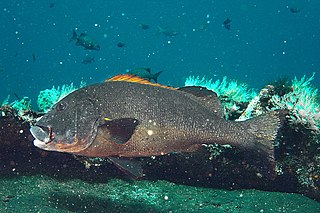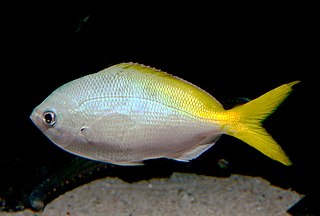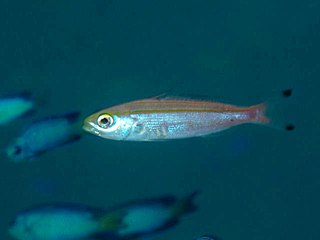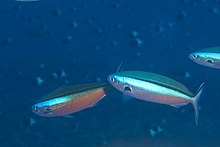
Caesionidae, the fusiliers, are a family of marine ray-finned fishes in the order Perciformes. The family includes about 23 species. They are related to the snappers, but adapted for feeding on plankton, rather than on larger prey. They are found at reefs in the Indo-Pacific and in the Red Sea.

Plectorhinchus albovittatus, the two-striped sweetlips or giant sweetlips, is a species of marine ray-finned fish, a sweetlips belonging to the subfamily Plectorhinchinae, part of the grunt family Haemulidae. It is native to the Indian Ocean and the western Pacific Ocean.

The sailfin snapper, blue-lined sea bream or blue-lined sea perch is a species of marine ray-finned fish, a snapper belonging to the family Lutjanidae. It is native to the Indo-Pacific region. It is of minor importance to local commercial fisheries and can be found in the aquarium trade. It is currently the only known member of its genus.

The yellowback fusilier is a pelagic marine ray-finned fish, a fusilier belonging to the family Caesionidae. It is native to the tropical Indo-Pacific, being found in shallow water from the East African coast to Indonesia.

The gold-band fusilier also known as the yellow-band fusilier or black-tipped fusilier, is a species of marine ray-finned fish, a fusilier belonging to the family Caesionidae. It is widespread around reefs in the Indo-West Pacific region.

Pterocaesio is a genus of marine ray-finned fish, fuiliers belonging to the family Caesionidae. They are native to the Indian Ocean and the western Pacific Ocean.

Caesio is a genus of marine ray-finned fish, fusiliers belonging to the family Caesionidae. They are native to the Indian Ocean and the western Pacific Ocean, although one species has invaded the eastern Mediterranean Sea through the Suez Canal by Lessepsian migration.

The mottled fusilier is a species of marine ray-finned fish, a fusilier belonging to the family Caesionidae. It has a broad Indo-Pacific distribution. It is the only species in the monotypic genus Dipterygonotus.

The slender fusilier is a species of marine ray-finned fish, a fusilier belonging to the family Caesionidae. It is native to tropical reefs in the Indian Ocean and the western Pacific Ocean, It is of minor importance to local commercial fisheries. This species is the only known member of its genus.

Caesio teres, the yellow and blueback fusilier, beautiful fusilier, blue and gold fusilier or yellow-tail fusilier, is a species of marine, pelagic ray-finned fish belonging to the family Caesionidae. It occurs in the Indian and Western Pacific Oceans.

Caesio caerulaurea, the blue and gold fusilier, blue fusilier, gold-band fusilier or scissor-tailed fusilier, is a species of marine fish in the family Caesionidae. It is widespread throughout the tropical waters of the Indo-Pacific area, including the Red Sea.

The lunar fusilier, also known as the blue fusilier or moon fusilier, is a species of marine ray-finned fish, a fusilier belonging to the family Caesionidae. It is widespread throughout the tropical waters of the Indo-West Pacific area.

The Chinamanfish, Chinaman snapper, galloper or thread-finned sea perch, is species of marine ray-finned fish, a snapper belonging to the family Lutjanidae. It is found in the Western Pacific Ocean.

Caesio varilineata, the variable-lined fusilier or thin-lined fusilier, is a species of pelagic marine ray-finned fish, a fusilier belonging to the family Caesionidae. It is found in the Indo-Pacific region.

Pterocaesio pisang, the banana fusilier or ruddy fusilier, is a species of marine ray-finned fish, a fusilier belonging to the family Caesionidae. It is widespread around reefs in the Indo-West Pacific region.

Caesio cuning, the redbelly yellowtail fusilier, yellowtail fusilier, red-bellied fusilier or robust fusilier, is a species of marine ray-finned fish, a fusilier belonging to the family Caesionidae. It is native to the Indian and Western Pacific Oceans.

Pterocaesio marri, Marr's fusilier, bigtail fusilier, blacktip fusilier, bananafish or twinstripe fusilier is a species of marine ray-finned fish, a fusilier belonging to the family Caesionidae. It is widespread around reefs in the Indo-West Pacific region.

Caesio suevica, the Suez fusilier, is a species of marine ray-finned fish, a fusilier belonging to the family Caesionidae. It is endemic to the Red Sea.

The double-lined fusilier, also known as the double stripe fusilier or blacktipped fusilier, is a species of marine ray-finned fish, a fusilier belonging to the family Caesionidae. It is widespread around reefs in the Indo-West Pacific region.

Etelis carbunculus, the deep-water red snapper, ruby snapper or longtail snapper, is a species of ray-finned fish, a snapper belonging to the family Lutjanidae. It is found in the Indo-Pacific region.





















